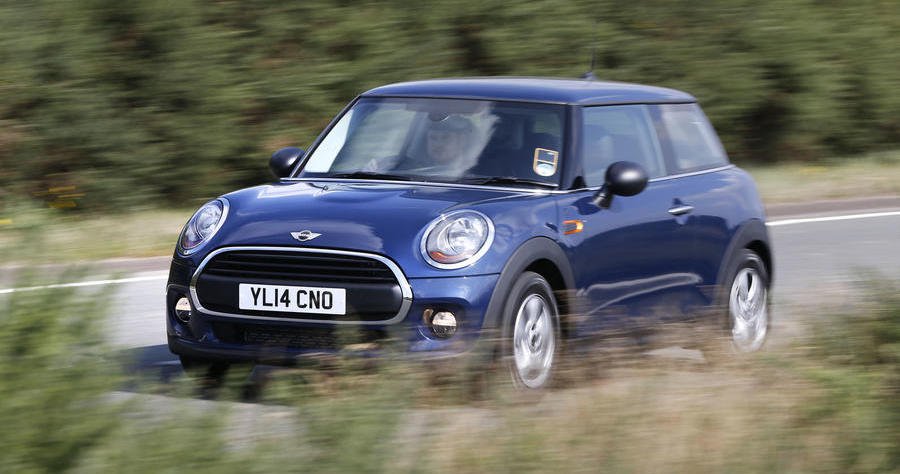The lazy charge that all new cars are the same these days could never be levelled at the current Mini under the spotlight here or, indeed, any Mini before it. Despite being bigger, safer and better equipped than ever before, it retains its forebears’ cheeky charm.
It was launched in 2014 in three and, for the first time, five-door bodystyles. The latter was made possible by the new car’s longer body, designed to boost space in the rear cabin and the boot. It was a success, there now being room for a couple of six-footers to make themselves reasonably comfortable. If you want to make the 211-litre boot a little bigger, the back seats split and fold. Up front, the five-door is much like the three-door, with ample room for driver and passenger to find their ideal position.
The new car was launched with a choice of petrol and diesel engines, although fast-forward to 2019 and only the petrols survive. Back in 2014, we were less squeamish, with the entry-level One being available with a 1.2 petrol or 1.5 diesel motor, the warmish Cooper with a 1.5 petrol or diesel and the properly warm Cooper S with an unfeasibly large 2.0-litre petrol or diesel. The range-topping John Cooper Works (three-door only) got a more powerful version of the 2.0-litre petrol.
A used Cooper isn’t much more expensive than a One, and the better buy, but a Cooper S is a lot more fun and good value. Meanwhile, the John Cooper Works is not quite as on point as its high price would have you think. There are cheaper and more rounded but no less incisive rivals out there. High-mileage One Ds dominate the cheaper end of the classifieds. They’re economical but, if you’re a townie, the petrols are the way to go.
The biggest adventure most buyers of a new Mini ever had is navigating their way through the options list. Low on food and water, most wave the white flag and shout for the Chili pack. In 2016, this gained LED headlights, while two more, called Tech Pack (it has a head-up display) and Yours Pack (styling tweaks), joined the range. These and the other option packs can add visual and functional appeal but remember that, like most options, they depreciate faster than the Mini they’re fitted to.
Four years after launch, in 2018 Mini One and Cooper got a shot in the arm thanks to some styling and infotainment updates, chief among them being the adoption of Union flag tail-lights. And then later that year, new styles called Classic, Sport and Exclusive that helped simplify the selection process as well as, more pertinently, streamline the new WLTP testing protocol, came into play.
With prices spanning £4500 for a 2015 One D to £38,000 for a 2018-reg John Cooper Works, there’s probably a Mk3 Mini to suit your pocket.
BUYER BEWARE
EngineRegular oil changes are essential not least for the health of the variable valve timing system.
TransmissionMake sure gears slot home and stay there. Some cars signal clutch wear when none is present. A dealer can reset the indicator but do some full power starts in a higher gear to see if the clutch slips before they do. Note: the clutch and dual-mass flywheel must be replaced together at considerable cost, at least on the Mini One.
SteeringCheck that the electrically powered steering is quiet and smooth. Some problems can be traced to insufficient power from the battery.
ElectricalEarly (2014-reg) cars can suffer failed wiring looms due to water ingress from the windscreen washers. In fact, water ingress has been a problem on a few Minis.
BodyworkLook for rubbing marks on the B-pillar where the door rubber has worn away the paint.
InteriorCheck you can connect your phone because there have been connectivity issues. Fortunately, most can be resolved with a software update.
Need to know
If you like the convenience of an automatic gearbox or it’s all you’re entitled to drive, it’s worth knowing that in late 2017 the Mini’s old six-speed torque converter was replaced by a smart seven-speed double-clutch affair that’s more efficient.
The Mini has no allowance for towing and there’s no approved towbar, so forget hitching up that trailer tent for your holidays. Meanwhile, roof boxes will only fit the original equipment roof rails, and they’re an expensive aftermarket add-on.
Mini’s TLC servicing package is an option available to first owners. It covers servicing for the car’s first three years or 36,000 miles. It’s transferable so it’s worth checking if a used Mini has it, which you can do on the Mini website.
Our pick
Cooper S 2.0 3dr: Quicker – just – than a Ford Fiesta ST from 0-62mph and over the quarter mile, and with lashings of mid-range torque for spirited in-gear sprints, it’s the Mini range’s sweet spot.
Wild card
Mini One 1.2: Silly looking on standard skinny tyres and not as economical as the Cooper but the three-pot is decently torquey, while the steering and handling are as delightful as ever.
Ones we found
2015 Cooper 1.5 D 3dr, 78,000 miles, £5800
2016 Cooper 1.5 3dr, 40,000 miles, £6995
2017 Cooper 1.5 D 5dr, 32,000 miles, £10,110
2018 Cooper S 2.0 3dr, 10,000 miles, £15,827

